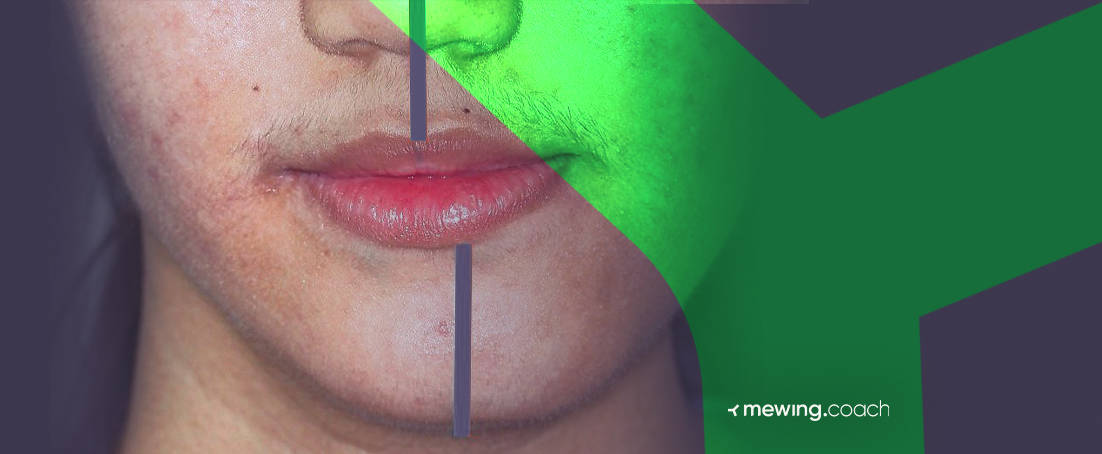Mewing is a tongue exercise that can fix facial posture and asymmetry to achieve a toned muscular jaw. This technique was initially introduced by Dr. Mew, who first performed mewing on his kid Mike Mew, and the experiment showed positive results.
Later he concluded that mewing also helps with sleep apnea, straightening a jaw or contributing to jaw development to reach symmetry.
Mewing requires a lot of practice to do it correctly, and improper exercise can make your face asymmetrical. To avoid tragic case scenarios, we’ve prepared a guide on how to do mewing correctly, where you’ll learn:
📍What causes an asymmetrical jawline
📍How mewing affects the jawline
📍Rookie mistakes to avoid
Let’s get started!

Causes of Asymmetrical Jaw Structure
Asymmetrical jaw development is a common facial defect that may occur because of the following:
- Broken jaw: If you’ve suffered a jaw fracture before, chances are it will slightly dislocate as the bones heal.
- TMJ disorders: The temporomandibular joint (TMJ) connects your jawbone to your skull like a moving bridge. Each side of your jaw has one joint. TMJ problems also referred to as TMJ disorders, can lead to pain in the periodontal ligament and the muscles that affect jaw movement.
- Congenital disabilities: Another possible cause for an asymmetrical jawline is being born with an uneven jaw. This may be a genetic predisposition or develop during birth. But, in both cases, it’s very individual.
The cause of asymmetrical jaw occurs when the bones, muscles, and tendons have disrupted workflow. An imbalance in any of these can cause differences in facial structure.
However, one Korean study finds that 20 weeks of continual facial exercise therapy improved the midfacial and lower facial lines. No need for surgery, only DIY treatment like mewing!
How to Even Out Asymmetrical Jaw With Mewing
One of the best ways to improve your facial definition is by doing regular tongue exercises. Mike Mew is living proof that practicing mewing can improve facial structures!
Here’s what you need to do:
- Put your tongue against the roof of the mouth, and keep the tip behind the front teeth. Make sure they’re not touching.
- Put the root of your tongue against the palate without allowing airflow between the palate and the tongue to achieve a good tongue position.
Doing these exercises right is important, as wrong mewing can cause crooked teeth or asymmetry. To help you avoid such worst-case scenarios, we’ve introduced the app Mewing.coach to navigate you through the “training” and assist you in reaching your goal.
Through our app, you’ll learn more about the mistakes to avoid while mewing and how to keep up with the exercises. It’s important to catch the appropriate rhythm to avoid developing another bad habit.
Mewing Results: Before and After Uneven Jaw
Many people feel satisfied and state that mewing is one of the better alternatives to facial cosmetic surgeries; and that it doesn’t cost a dime! However, you can always check out some before & after jaw transformations, thanks to mewing, to get an idea of how it can help.
Clients report an improved aesthetic look, which has given them a confidence boost like no other! Not to mention the comfort that follows once you shift your jaw to its appropriate, most natural position.
Mind that a misaligned jaw might need surgical correction in some cases – especially if too drastic.
How Long Does It Take to Fix Uneven Jaw while Mewing
The time needed to fix a deformed jaw is relative. Some people need more time practicing, while others need less. Regardless, the optimal mewing exercising time is 20-30 minutes daily, also called soft mewing.
If you want to get better results, you should try hard mewing. It promotes the same proper tongue posture as soft or regular mewing. The only difference here is that you will have to apply more pressure to your tongue muscles as if you’re pushing into your skull.
However, you must be cautious about doing the exercise correctly because you might have unwanted results. Mewing affects jawline muscles in direct proportion to how you direct them with pressure and tongue posture.
Regarding the time you must spend doing hard mewing, we suggest you stick with the exercise as long as possible. You can even do it while eating by chewing the food with the tongue pushing toward the palate. Tongue chewing should be equal on both sides for optimal results.
How to Prevent Asymmetrical Jaw Recurrence
After a series of regular mewing, you will notice a standard improvement. Unfortunately, if you stop the exercise, the oral posture will return to its original state.
Jaw relapses after mewing for an uneven jaw are completely normal, especially in teenagers and young adults till their mid-20s. Our bones grow and change until the age of 26, increasing the chances of recurrence.
However, if you don’t feel like constantly mewing, you have other alternatives to prevent asymmetrical jaw recurrence:
- Avoid mouth breathing
- Avoid soft foods and try eating harder foods and chewing gum
- Avoid chewing food on one side, and make sure you chew evenly.
Ongoing proper tongue alignment reduces the chances of your jaw turning asymmetrical again.
Other Uneven Jaw Treatments
Just like any other corrective physical therapy, mewing works with jaws with lighter defects. In case of a misaligned jaw or malocclusion, a medical professional may suggest jaw surgery because some defects cannot be fixed only with therapy.
There are a few types of options you may be presented with, and here’s what they mean:
- Maxillary osteotomy: This upper jaw surgery is used to repair open bites or crossbites. You may also find it under ‘maxillofacial surgery.’ the upper jaw and teeth are advanced to line with the lower jaw and teeth.
- Mandibular osteotomy: This is a protruding bottom jaw surgery used to repair overbites. In this case, the surgeon will have to cut out the back of your mouth to align your jaws to a normal posture.
- Genioplasty: This type of surgery repairs crooked or smaller chins. During this surgery, the doctor will restructure the chin bone in front of the jaw.
- Jaw wiring: Jaw wiring is a procedure during which a medical professional tightly closes your jaw for a designated period.
In short – this is what you can expect if you ever require facial surgery.
Can Mewing Fix Uneven Jaw? Final Say
Every person’s face is one of a kind, and depending on the deformity in the facial structure, doctors determine whether it’s correctable with physical exercise or surgery.
Nonetheless, mewing as an alternative to an invasive procedure is gaining more popularity because it’s natural and it doesn’t involve any surgeries. Plus, many people claim that mewing actually works, and we should embrace it!
With intensified exercises, you can get results faster, but remember that any irregular posture may bring worse results. Therefore, make sure your tongue is in the right position every time you mew, and you’re good to go!





